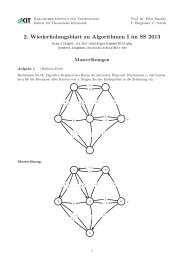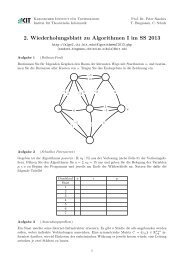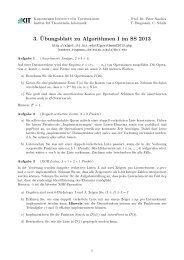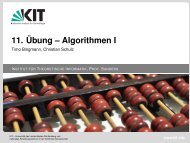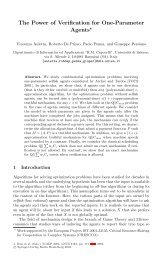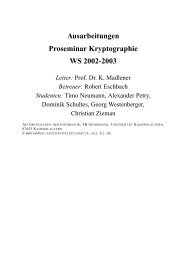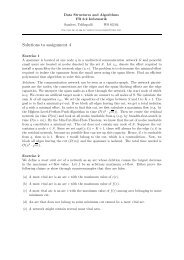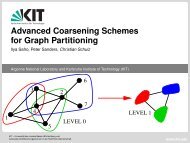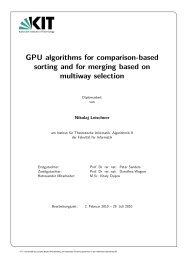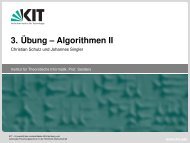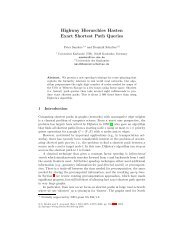Stxxl : Standard Template Library for XXL Data Sets - Max-Planck ...
Stxxl : Standard Template Library for XXL Data Sets - Max-Planck ...
Stxxl : Standard Template Library for XXL Data Sets - Max-Planck ...
Create successful ePaper yourself
Turn your PDF publications into a flip-book with our unique Google optimized e-Paper software.
Listing 6: Computing a <strong>Max</strong>imal Independent Set using <strong>Stxxl</strong>.<br />
1 struct node_greater : public std : : greater {<br />
2 node_type min_value () const {<br />
3 return std : : numeric_limits::max ( ) ;<br />
4 }<br />
5 };<br />
6 typedef stxxl : : PRIORITY_QUEUE_GENERATOR::result pq_type ;<br />
8 pq_type depend (PQ_PPOOL_MEM ,PQ_WPOOL_MEM ) ; // keeps ”not in MIS” events<br />
9 stxxl : : vector MIS ; // output<br />
10 <strong>for</strong> ( ; ! edges .empty();++edges) {<br />
11 while ( ! depend .empty () && edges−>src > depend .top ())<br />
12 depend .pop ( ) ; // delete old events<br />
13 if (depend .empty () | | edges−>src != depend .top () ) {<br />
14 if (MIS .empty () | | MIS .back () != edges−>src )<br />
15 MIS .push_back (edges−>src ) ;<br />
16 depend .push (edges−>dst ) ;<br />
17 }<br />
18 }<br />
includes the running time of the input generation.<br />
Now we describe the MIS algorithm implementation in Listing 6, which is only nine lines long<br />
not including declarations. The algorithm visits the graph nodes scanning lexicographically sorted<br />
input edges. When a node is visited, we add it to the maximal independent set if none of its visited<br />
neighbours is already in the MIS. The neighbour nodes of the MIS nodes are stored as events<br />
in a priority queue. In Lines 6-7, the template metaprogram [12] PRIORITY QUEUE GENERATOR<br />
computes the type of priority queue that will store events. The metaprogram finds the optimal<br />
values <strong>for</strong> numerous tuning parameters (the number and the maximum arity of external/internal<br />
mergers, the size of merge buffers, external memory block size, etc.) under the constraint<br />
that the total size of the priority queue internal buffers must be limited by PQ MEM bytes. The<br />
node greater comparison functor defines the order of nodes of type node type and minimum<br />
value that a node object can have, such that the top() method will return the smallest contained<br />
element. The last template parameter tells that the priority queue can not contain more than<br />
INPUT SIZE elements (in 1024 units). Line 8 creates the priority queue depend having prefetch<br />
buffer pool of sizePQ PPOOL MEM bytes and buffered write memory pool of sizePQ WPOOL MEM bytes.<br />
The external vector MIS stores the nodes belonging to the maximal independent set. Ordered<br />
input edges come in the <strong>for</strong>m of an <strong>Stxxl</strong> stream called edges. If the current node edges->src<br />
is not a neighbour of a MIS node (the comparison with the current eventdepend.top(), Line 13),<br />
then it is included in MIS (if it was not there be<strong>for</strong>e, Line 15). All neighbour nodes edges->dst of<br />
a node in MIS edges->src are inserted in the event priority queue depend (Line 16). Lines 11-12<br />
remove the events already passed through from the priority queue.<br />
To make a comparison with other external memory libraries, we have implemented the<br />
graph generation algorithm using TPIE and LEDA-SM libraries. The MIS algorithm was implemented<br />
in LEDA-SM using its array heap data structure as a priority queue. The I/Oefficient<br />
implementation of the MIS algorithm was not possible in TPIE, since it does not<br />
have an I/O efficient priority queue implementation. For TPIE, we report only the running<br />
time of the graph generation. The source code of all our implementations is available under<br />
http://i10www.ira.uka.de/dementiev/stxxl/paper/index.shtml.<br />
To make the benchmark closer to real applications, we have added two 32-bit integer fields in<br />
the edge data structure, which can store some additional in<strong>for</strong>mation associated with the edge.<br />
14



